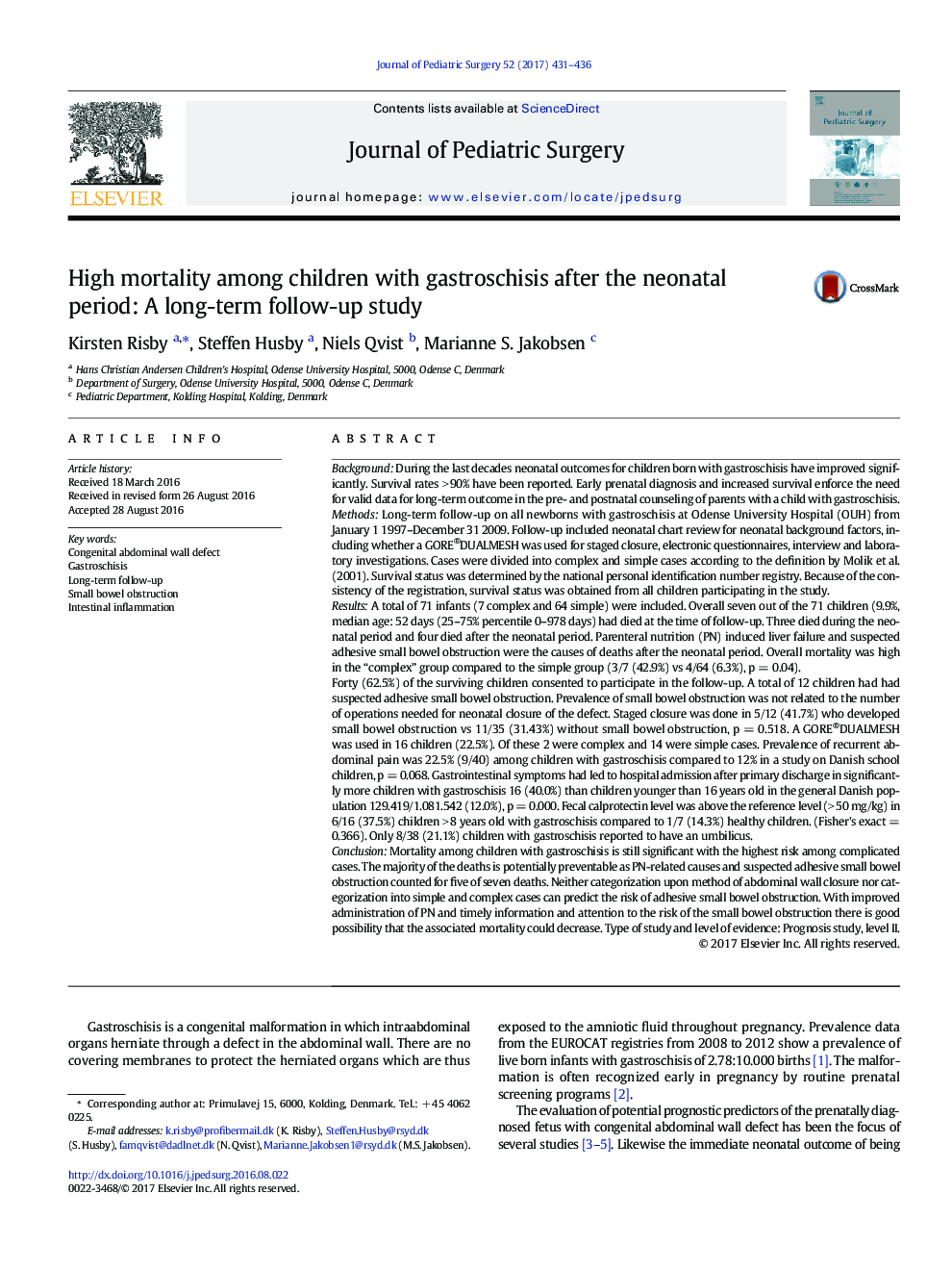| کد مقاله | کد نشریه | سال انتشار | مقاله انگلیسی | نسخه تمام متن |
|---|---|---|---|---|
| 5718173 | 1411243 | 2017 | 6 صفحه PDF | دانلود رایگان |
BackgroundDuring the last decades neonatal outcomes for children born with gastroschisis have improved significantly. Survival rates > 90% have been reported. Early prenatal diagnosis and increased survival enforce the need for valid data for long-term outcome in the pre- and postnatal counseling of parents with a child with gastroschisis.MethodsLong-term follow-up on all newborns with gastroschisis at Odense University Hospital (OUH) from January 1 1997-December 31 2009. Follow-up included neonatal chart review for neonatal background factors, including whether a GORE®DUALMESH was used for staged closure, electronic questionnaires, interview and laboratory investigations. Cases were divided into complex and simple cases according to the definition by Molik et al. (2001). Survival status was determined by the national personal identification number registry. Because of the consistency of the registration, survival status was obtained from all children participating in the study.ResultsA total of 71 infants (7 complex and 64 simple) were included. Overall seven out of the 71 children (9.9%, median age: 52 days (25-75% percentile 0-978 days) had died at the time of follow-up. Three died during the neonatal period and four died after the neonatal period. Parenteral nutrition (PN) induced liver failure and suspected adhesive small bowel obstruction were the causes of deaths after the neonatal period. Overall mortality was high in the “complex” group compared to the simple group (3/7 (42.9%) vs 4/64 (6.3%), p = 0.04).Forty (62.5%) of the surviving children consented to participate in the follow-up. A total of 12 children had had suspected adhesive small bowel obstruction. Prevalence of small bowel obstruction was not related to the number of operations needed for neonatal closure of the defect. Staged closure was done in 5/12 (41.7%) who developed small bowel obstruction vs 11/35 (31.43%) without small bowel obstruction, p = 0.518. A GORE®DUALMESH was used in 16 children (22.5%). Of these 2 were complex and 14 were simple cases. Prevalence of recurrent abdominal pain was 22.5% (9/40) among children with gastroschisis compared to 12% in a study on Danish school children, p = 0.068. Gastrointestinal symptoms had led to hospital admission after primary discharge in significantly more children with gastroschisis 16 (40.0%) than children younger than 16 years old in the general Danish population 129.419/1.081.542 (12.0%), p = 0.000. Fecal calprotectin level was above the reference level (> 50 mg/kg) in 6/16 (37.5%) children > 8 years old with gastroschisis compared to 1/7 (14.3%) healthy children. (Fisher's exact = 0.366). Only 8/38 (21.1%) children with gastroschisis reported to have an umbilicus.ConclusionMortality among children with gastroschisis is still significant with the highest risk among complicated cases. The majority of the deaths is potentially preventable as PN-related causes and suspected adhesive small bowel obstruction counted for five of seven deaths. Neither categorization upon method of abdominal wall closure nor categorization into simple and complex cases can predict the risk of adhesive small bowel obstruction. With improved administration of PN and timely information and attention to the risk of the small bowel obstruction there is good possibility that the associated mortality could decrease. Type of study and level of evidence: Prognosis study, level II.
Journal: Journal of Pediatric Surgery - Volume 52, Issue 3, March 2017, Pages 431-436
